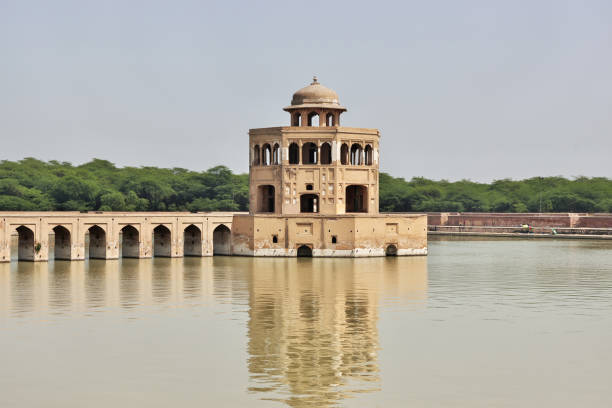What Makes Hiran Minar a Historical Gem?
.jpeg)
Hiran Minar stands freely on top of the historical ramp structure that dominates the area. Originally constructed in the early part of the seventeenth century by Emperor Jahangir .As a hunting chateau and lover’s gift to his pet antelope, Mansraj. It also remains vivid that the Mughal dynasty has left behind an impressive number of architectural masterpieces. As well as profound respect for nature.
This consists of a round tower or minaret, a vast round water –stair or cistern. A fine circular pavilion joined to the minaret by a bridge or causeway. The detached 30-meter tall minar has the elements of architectural ornamentation carved into the stones. Environment is both a mirror of the relaxed, symmetrical aesthetic of Mugal Lifestyle and a passion for gardening. Hiran Minar also acted as a royal lodge and a place for shikar, which had provisions for all activities, and looked royal.
The present era has realized Hiran Minar as a cultural and historical site. Tourists visit the site to experience three main attractions: peaceful surroundings together with remarkable design and historical importance. It deploys the technique that is characteristic of Mughals of putting art, nature and engineering into one flow.
The Mughal Legacy Behind Hiran Minar’s Creation
Hiran Minar located near to Sheikhupura, Punjab, Pakistan is one of the excellent example of the Mughal architecture and historical point of interest . Which shows the love of the Emperor Jahangir for animals nature and art. The inventive architectural kind and Mughals share an intimate connection through this structure. Construction and Origin
- Emperor Jahangir’s Reign:
Hiran Minar became finished as an architectural structure during 1600 AD before both sites were built. At the instance of Jahangir in the memory of his pet antelope Mansraj. The construction of this monument traces back to great emperor Jahangir who Showed keen interest in natural wildlife leading to his deep respect for animal species. Hiran Minar means Deer Tower. The building commissioned during the early seventeenth century specifically held the name of antelope. Jahangir paid tribute to his beloved clipped antelope Mansraj from 1606 to 1620 through its construction. His Majesty also had amateur artist skills while enjoying to amass hunting-related items and wildlife relics. The monument demonstrates the emperor’s natural affection through its representation of animals. The name Hiran Minar means ‘Deer Tower’ which has reference to the antelope.
- Purpose:
Initially constructed for Mansraj it evolved into a royal hunting lodge that became a playground for the elite Mughal royal family. There were earlier other entertainment and recreational areas around Hiran Minar to accompany and support hunting of the emperor and his peers.
- Architectural Features:
Exploring the Unique Structure and Layout of Hiran Minar
The structure consists of a round building, with a height of 30 meters and adorned interior . Exterior with the image of the antelope with carved inscriptions on it. It also had the function with reference to showing the location of the royal hunting ground.
- Water Tank and Pavilion:
The enlarged square water reservoir encircles the entire structure from every side yet maintains identical plans with the building structure itself. The interior of which has the appearance of a minar having in the centre of the water channel a baradari. But as the baradari structured for recreation and other leisure activities of the royally it fulfilled its needed purpose.
The architectural design of the water tank as well as hydraulic system in supplying water supported . By WA device was the evidence that displayed the perfect workmanship of the Mughals in engineering.
- Shah Jahan’s Modifications:
The subsequent monarch Shah Jahan carried out a renovation which incorporated various adjustments to the structure.
Like strengthening of chhatri, alteration in the geometry of water regulating systems of the place etc.
- Post-Mughal Era:
After the decline of Mughals this site faded and witnessed huge abandonments but it beautifully captured the history and architectural style. The provincial authority of Britishers in Indian territory realized the worth and tried to conserve it.
Modern Importance:
Hiran Minar stands today as a structure which shows most clearly the Mughal legacy and how they wished to interact with nature. People draw tourists here because the site is quiet and contains historical background. The complex depicts Mughal architectural elements in a form that unites practicality with passion along with historic elements.
How the Site is Maintained and Protected ?
Purpose:
The walls of the complex were used as hunting recreation center after the death of the antelope Mansraj. On Mansraj a circular minaret of 30 meters high built for Mantra the favorite antelope of the Emperor was later embellished with carvings on stone and inscriptions of record made by the subsequent rulers who expanded the complex and added pavilion and water facilities.
3. Historical Context:
The structure was time and built during the period of Emperor Jahangir between 1606 and1620.
Jahangir, who was not only a nature lover but also a prolific one did this area of the country as his shikargah (royal hunting ground).
It is creating the Mughal emblem of integrating functional aesthetic and nature harmony reflecting the idea of nature as the source, a perfect beauty.
What Visitors Can Experience at Hiran Minar ?
This is a very Mughal heavy piece, stressing on ‘weight’ as a divine characteristic of the Mughal arts offered by other incredibly selected artworks of the Mughal rulers. The monument was actually Emperor Jahangir’s memorial to his favorite deer called Mansraj, which made it famous, yet that reputation came from the fact that it was not only an astounding architectural work but also a terraced wall, a water tank, and a baradari pavilion all in one structure. My limited, basic writing skills allow me to tell this story, that it once was such a place where not only the royals came to hunt but also that it was a recreational retreat as well.
